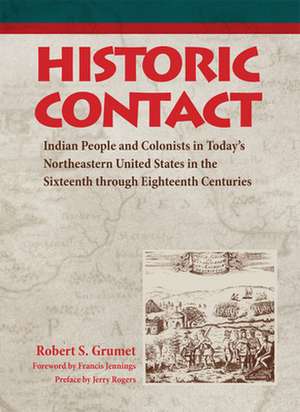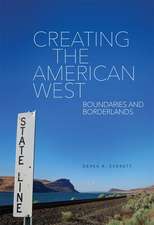Historic Contact: Indian People and Colonists in Today's Northeastern United States in the Sixteenth Through Eighteent: Contributions to Public Archeology
Autor Robert S. Grumet, Francis Jennings, Jerry Rogersen Limba Engleză Hardback – 30 noi 1995
Anthropologist and preservationist Robert S. Grumet has created this up-to-date, well-written overview of historic contact with Native Americans on the colonial frontier from a vast array of documentary, archaeological, and ethnographic data never assembled before. This is a definitive history of early Indian-white relations in an area extending from Virginia to Maine and from the Atlantic coast to the upper Ohio River. It will be read by specialists and Indian-studies buffs alike.
"Historic Contact" divides native northeastern America into three subregions where the histories of thirty-four Indian Countries are described and mapped in detail, including all National Historic Landmarks. In the North Atlantic Region are the Eastern and Western Abenaki, Pocumtuck-Squakheag, Nipmuck, Pennacook-Pawtucket, Massachusett, Wampanoag, Narragansett, Mohegan-Pequot, Montauk, Lower Connecticut Valley, and Mahican Indian Countries; in the Middle Atlantic Region, the Munsee, Delaware, Nanticoke, Piscataway-Potomac, Powhatan, Nottoway-Meherrin, Upper Potomac-Shenandoah, Virginian Piedmont, Southern Appalachian Highlands, and lower Susquehanna Indian Countries; and in the Trans-Appalachian Region, the Mohawl, Oneida, Cayuga, Seneca, Niagara-Erie, Upper Susquehanna, and Upper Ohio Indian Countries.
Readers interested in Indian history and colonial America will value this basic reference, which originated as a National Historic landmarks Survey Theme Study. Federal agencies, state and local preservation officers, and Indian communities will use it as an excellent planning tool in making evaluations protection decisions.
| Toate formatele și edițiile | Preț | Express |
|---|---|---|
| Paperback (1) | 297.74 lei 6-8 săpt. | |
| University of Oklahoma Press – 28 iun 2021 | 297.74 lei 6-8 săpt. | |
| Hardback (1) | 461.70 lei 6-8 săpt. | |
| University of Oklahoma Press – 30 noi 1995 | 461.70 lei 6-8 săpt. |
Preț: 461.70 lei
Nou
88.37€ • 91.91$ • 74.05£
Carte tipărită la comandă
Livrare economică 13-27 martie
Specificații
ISBN-10: 0806127007
Pagini: 554
Dimensiuni: 186 x 260 x 35 mm
Greutate: 1.19 kg
Ediția:New.
Editura: University of Oklahoma Press
Seria Contributions to Public Archeology


















